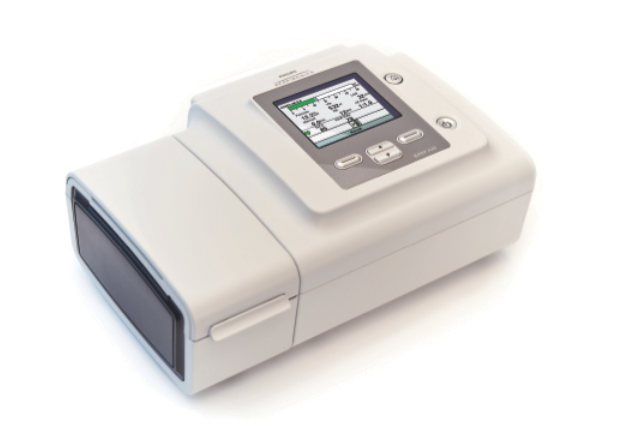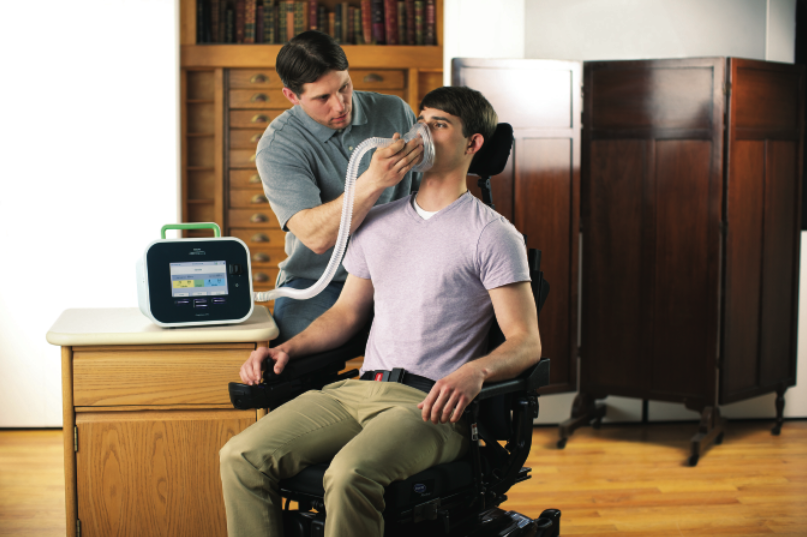What is mechanical ventilation?
Mechanical ventilation is a method of assisting or replacing your own effort of breathing though mechanical means.
Types of mechanical ventilation
There are two ways of providing ventilation: non-invasively and invasively
Non-invasive ventilation (NIV) uses a mask or other type of interface to deliver air from a ventilator. This does not require a surgical procedure.
Invasive ventilation delivers air via tubing from a ventilator through a tracheostomy, which is inserted through a surgically created hole in the windpipe (trachea).
The right kind of ventilation depends on the person and their medical needs. Many factors will influence your decision about options and should be discussed and your physician.
Non Invasive Ventilation
 Non invasive ventilation, such as Respironic’s Bi-PAP with Average Volume Assured Pressure Support (AVAPS) is a relatively new and exciting advancement in providing neuromuscular patients with non invasive ventilation (NIV) options. Our Respiratory Therapists will work with you to ensure you become comfortable using the therapy, and obtain the maximum benefit from the technology. We work closely with the referring Physician team to help you with your breathing, and achieve the personal goals you have set for yourself. Whether you have been diagnosed with ALS, Muscular Dystrophy, or another neuromuscular disorder, if your breathing is affected, we have the knowledge, the experience, and the right equipment to help you.
Non invasive ventilation, such as Respironic’s Bi-PAP with Average Volume Assured Pressure Support (AVAPS) is a relatively new and exciting advancement in providing neuromuscular patients with non invasive ventilation (NIV) options. Our Respiratory Therapists will work with you to ensure you become comfortable using the therapy, and obtain the maximum benefit from the technology. We work closely with the referring Physician team to help you with your breathing, and achieve the personal goals you have set for yourself. Whether you have been diagnosed with ALS, Muscular Dystrophy, or another neuromuscular disorder, if your breathing is affected, we have the knowledge, the experience, and the right equipment to help you.
Assistive Devices
Cough Assist – It Coughs when Patients can’t An important therapy for everyday lung hygiene is the ability to cough and expectorate mucous build up in your lungs. Patients afflicted with neuromuscular disease and some spinal cord injuries often have a reduced ability to cough effectively. This leads to an increased risk for lung infection. The Cough Assist by Respironics is designed to give the user a large breath, then rapidly draw the inhaled breath from the lungs, simulating a cough. If you have a prescription from your Doctor for Cough Assist, our Respiratory Therapists would be pleased to make an appointment with you to trial the Cough Assist for a few weeks to determine if this therapy is helping you with your ability to keep your lungs free of mucous build up.
Lung Volume Recruitment Device – Patients who are afflicted with neuromuscular disease, spinal cord injury (and some other health problems) which affect their ability to take a deep breath, should have the ability to take a deep breath occasionally. Deep breathing keeps the lungs open, optimizes Oxygenation, and reduces the risk for a lung infection.

The LVR is designed to help you take a deep breath and keep your lungs open and free of mucous build up. If your doctor has precsribed an LVR for you, call us for an appointment. Almost all patients with weakened breathing muscles benefit from LVR therapy.
